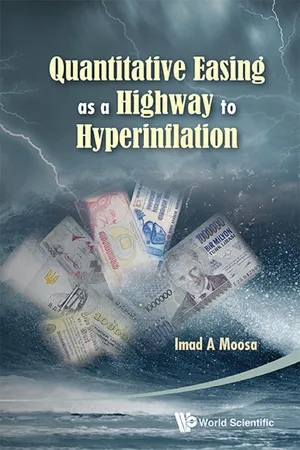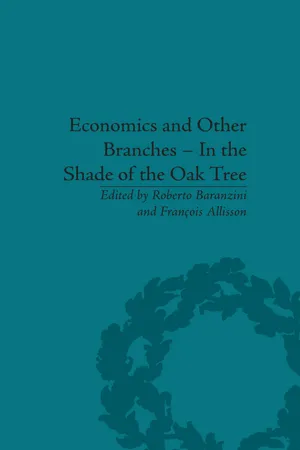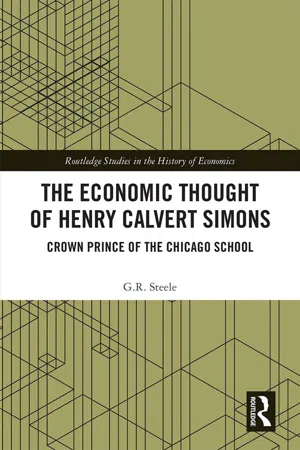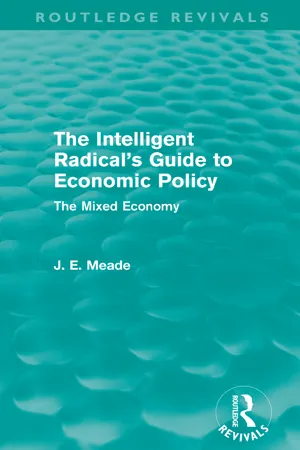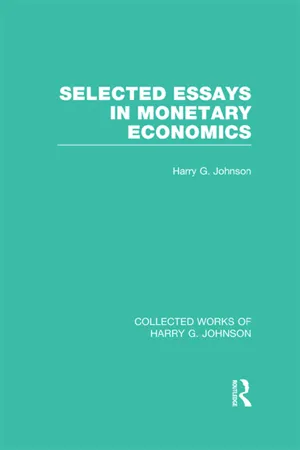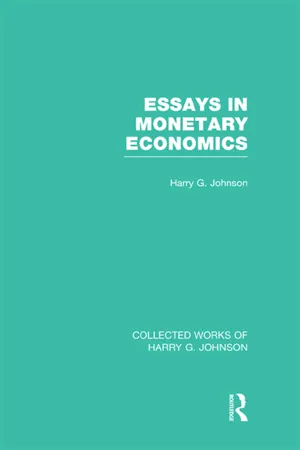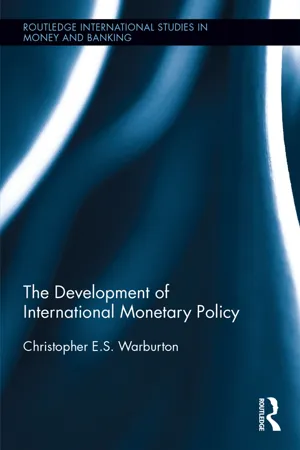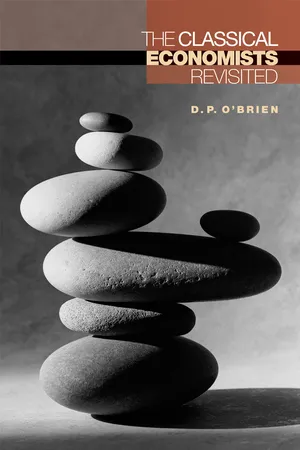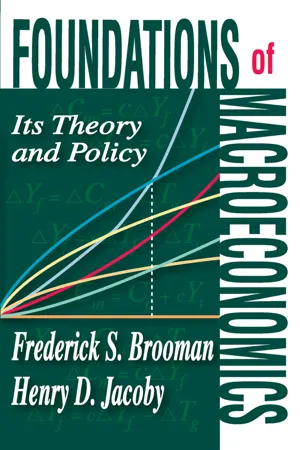Economics
Monetarist Theory of Inflation
The Monetarist Theory of Inflation, associated with economist Milton Friedman, posits that inflation is primarily caused by an increase in the money supply. According to this theory, when the government prints more money, it leads to an excess of money in the economy, driving up prices. Monetarists advocate for controlling inflation by regulating the growth of the money supply.
Written by Perlego with AI-assistance
Related key terms
10 Key excerpts on "Monetarist Theory of Inflation"
- Imad A Moosa(Author)
- 2013(Publication Date)
- WSPC(Publisher)
Chapter 3 THE MONETARY THEORY OF INFLATION 3.1.IntroductionThe idea behind the monetary theory of inflation is simple. If more money is created than what is required to buy goods and services, prices will rise — that is, the value of money in terms of goods and services (or the purchasing power of money) will decline. Inflation, in other words, arises when too much money chases too few goods. In the 19th century, the relation between the money supply and inflation was articulated by Joplin (1826) as follows:There is no opinion better established, though it is seldom consistently maintained, than that the general scale of prices existing in every country, is determined by the amount of money which circulates in it.In the 20th century, Milton Friedman appeared as the most outspoken advocate of the monetary theory of inflation. A famous quote from Friedman that is often repeated in the literature and the media is that “inflation is always and everywhere a monetary phenomenon” (Friedman, 1963).An increase in the quantity of money is typically taken to be synonymous with the debasement of the medium of exchange. Episodes of debasement have occurred throughout history and involved different forms of money. For example, when gold was used as a currency, the government could collect gold coins, melt them down, mix them with cheaper metals (such as silver, copper or lead), and re-issue them at the same nominal value. By diluting gold with other metals, the government could issue more coins without increasing the amount of gold required to make them. The government profits from an increase in seigniorage (which is the difference between the nominal value of a coin and the cost of producing it), when the cost of producing coins is reduced in this way. As a result, the value of coins declines in terms of goods while goods’ prices rise, which means that monetary inflation leads to price inflation.- eBook - ePub
Economics and Other Branches – In the Shade of the Oak Tree
Essays in Honour of Pascal Bridel
- François Allisson(Author)
- 2015(Publication Date)
- Routledge(Publisher)
Its interpretation of the essentially monetary nature of inflation, its claims about the likely futility of trying to engender improved real economic performance by pursuing a rising price level, and hence the desirability of making low and stable inflation the central goal of monetary policy, became widely accepted, and remain so today. However, New Classical economics’ so-called ‘monetary surprise’ model of the cycle, which embodied the monetarist hypothesis about the prime importance of variations in the growth rate of the money supply in driving short-run macroeconomic behaviour, did not survive its encounters with empirical evidence, 47 while monetarism’s preferred means of pursuing medium-term price stability – money growth targeting – would also prove fragile when actual policy was based upon it: one such scheme arguably served as a useful cover for the Volcker disinflation of the early 1980s, but the approach was otherwise soon judged impractical in the US, and similar regimes suffered the same fate in many other places too. What then emerged on the policy front under these twin impulses, aided and abetted by Milton Friedman’s spectacularly wrong forecast in 1983–4 that the rapid money growth then in progress would soon lead to a resurgence of inflation, 48 was a sort of ‘Monetarism without money’. 49 The micro-foundations of this new approach were grounded in real business cycle theory, itself drawn from the same tradition in neoclassical growth theory to which Sidrauski had been a seminal contribution, 50 and on the policy front, it retained earlier emphasis on low and stable inflation as a goal and continued to stress the importance of inflation-expectations in models of how to attain it. Crucially, however, it replaced money growth with a nominal interest rate as the central bank’s key instrument - eBook - ePub
The Economic Thought of Henry Calvert Simons
Crown Prince of the Chicago School
- G.R. Steele(Author)
- 2018(Publication Date)
- Routledge(Publisher)
Towards the end of the 1960s, US sovereign debt began to rise rapidly. Within the context of the international currency parities that had been fixed to the US dollar at Bretton Woods in 1944, the inevitable result was that price inflation – so obviously initiated by policy in the US – became a general feature across Western economies. The empirical Phillips curve trade-off (of a stable inverse relationship between percentage wage increases and unemployment) vanished, exactly as Milton Friedman (1968) and Edmund Phelps (1967) had anticipated. Freidman’s reputation soared:It was only then that the Keynesian orthodoxy encountered the full force of the Monetarist counter-revolution.What was new was his statement that there is a direct link between monetary growth and inflation through the medium of inflation expectations in the labour market. This statement was so distinct from Keynesianism that it became necessary to invent a new label for such an idea. In 1968, Karl Brunner called it ‘monetarism’ and the name stuck.(Foster, 1987, p. 42)8.2 The quantity theory of money
Monetarism: the novelty of a new name tends to obscure its relevant antecedents. The basic idea is that price inflation is determined by the prior excessive growth of money. Alternatively stated, inflation is currency debasement. However, the quantity theory of money has invited considerable inventiveness and embellishment since attention was first taken by the impact of money upon trade and industry. Which are the key transmission mechanisms between money and prices? Friedman’s ‘The Quantity Theory of Money. A Restatement’ (Friedman, 1956) describes a transmission based upon adjustments to portfolios of financial assets – i.e., the exact same mechanism upon which Keynes bases his liquidity preference theory of interest rate determination. By Keynes’s presentation, with an economy at under-full employment, the liquidity preference theory of interest rate determination is held to be more plausible than the classical loanable funds theory.2Although the basic idea of the quantity theory of money is traceable to ancient times, an early ‘theoretically satisfactory presentation’ (Schumpeter, 1954, p. 311) is credited to Jean Bodin (1568); but it was John Stuart Mill (1848) who brought precision to the idea: - eBook - ePub
- James E. Meade(Author)
- 2012(Publication Date)
- Routledge(Publisher)
II
The Control of Inflation
A necessary condition for the design of an effective set of radical economic policies and institutions is the existence of a monetary unit of account with a more or less dependable, stable, real purchasing power. Accordingly in this chapter we shall attempt to outline : first, the mechanisms of price inflation; second, the disadvantages, particularly for the radical’s set of policies, of price inflation; and, third, in the light of the mechanisms and disadvantages of inflation the design of policies for the control of inflation by means which will help rather than hinder the intelligent radical’s package of other economic policies.By inflation we mean simply a rise in the general level of money prices of goods and services. The causes of an inflationary situation are often divided into two groups, namely those which originate from a demand inflation and those which originate from a cost inflation. It is convenient to consider the phenomenon of price inflation under these two broad headings, though, as we shall see, the two types of inflation are in fact very closely interconnected.A demand inflation occurs when there is ‘too much money chasing too few goods’. The total demand for the goods and services produced in a country can be catalogued under the following four heads : (1) the expenditure by individual citizens for the purchase of domestically produced goods and services for individual consumption – food, clothing, heating, and other consumption goods; (2) the expenditure by business concerns on domestically produced buildings, machinery, plant, and other equipment in order to invest in additional productive capacity; (3) the purchase by the government and local authorities of domestically produced goods and services for public purposes; and (4) the purchase by foreigners of exports of the country’s domestically produced goods and services. - Harry Johnson(Author)
- 2013(Publication Date)
- Routledge(Publisher)
1 It is possible to detect some redistribution among particular groups; but for this type of model to be proved useful for the analysis of inflation, it would be necessary to establish that the inflationary mechanism works by redistributing income among major income-receiving groups. This in turn would require that some of such groups be unable or unwilling to protect their real incomes from the impact of inflation; in fact, on the contrary, such protection is available to all groups in a freely competitive system, through negotiation of contracts to take account of expected inflation, and is increasingly resorted to as the fact of inflation is recognized. Consequently the Keynesian approach to inflation in terms of income redistribution seems less satisfactory than the alternative quantity theory approach to which I now turn, an approach which concentrates on the effects of inflation on wealth rather than on real income and its distribution.IV. THE QUANTITY THEORY APPROACH TO INFLATIONThe quantity theory approach to inflation differs essentially from that of the Keynesian models just discussed in the basic assumptions from which it starts: instead of assuming that wage changes provoke price changes and conversely through institutionally given (and therefore arbitrary) reaction coefficients it assumes that in an inflation the economy becomes accustomed to the expectation of continued inflation, so that the processes of determining wages and prices are fundamentally real processes and not arbitrary processes determined exogenously. The basic postulate of the quantity theory models of inflation is that there is a stable demand function for money in real terms, into which the rate of inflation enters as a cost of holding real balances, which cost influences the quantity of real balances held. Given this function, the rate of increase of the nominal stock of money determines the rate of inflation, the public eventually coming to expect that rate of inflation and adjusting its stock of real balances (or ratio of real balances to real income) to it. In order to maintain its real balances constant in the face of inflation, the public must accumulate money balances at a rate equal to the rate of inflation; this accumulation of money balances in order to preserve real balances is achieved at the cost of sacrificing the consumption of current real income in order to maintain real balances intact, the release of current real income constituting the equivalent of a ‘tax’ on the holders of real balances; the tax on real balances, in turn, accrues as revenue to the beneficiaries of the inflationary increase in the money supply.1- eBook - ePub
- Brian Snowdon, Howard Vane(Authors)
- 1997(Publication Date)
- Routledge(Publisher)
Part IIThe monetarist counterrevolution
Passage contains an image
Introduction
‘Monetarism’, a term first introduced by Karl Brunner (1968), refers to a school of economic thought which initially evolved in the United States to attack the orthodox Keynesian analysis and associated policy-activism of the 1950s and 1960s. The historical development of the orthodox monetarist school can be traced in three main stages (see Snowdon et al. 1994). The first main stage, from the mid-1950s to the mid-1960s, involved an attempt, by Professor Milton Friedman and his associates, to re-establish the quantity theory of money approach to macroeconomic analysis. In this approach changes in the money supply are regarded as the predominant, though not the only, factor explaining changes in money income. Friedman’s (1956) seminal article on ‘The Quantity Theory of Money: A Restatement’ in which he asserted that the demand for money (and by implication velocity) is a stable function of a limited number of variables lies at the heart of the modern quantity theory approach. However, it was the breadth and depth of empirical evidence cited in Friedman and Schwartz’s (1963) book on A Monetary History of the United States, 1867–1960 which was particularly influential in reviving interest in the potency of money in generating cyclical fluctuations. Their analysis of the US historical record provided strong support for the view that independent movements of the stock of money played a significant role in causing macroeconomic instability. According to Lucas (1994) this book played ‘an important—perhaps even decisive—role in the 1960s’ debates over stabilization policy between Keynesians and monetarists’.The second main stage in the development of orthodox monetarism involved the expectations-augmented Phillips curve analysis which was absorbed into monetarist analysis after the mid-to-late 1960s. Central to this phase is Friedman’s 1967 Presidential Address to the American Economic Association, subsequently published in 1968 in the American Economic Review as ‘The Role of Monetary Policy’. In this article (reprinted on pp. 164–79) Friedman denies the existence of a permanent/long-run trade-off between inflation and unemployment and introduces the natural rate of unemployment hypothesis. The essence of this hypothesis is a reaffirmation of the classical view that in the long run nominal magnitudes cannot determine real magnitudes such as employment and output. According to Friedman monetary policy cannot, other than for very limited periods, achieve some target unemployment rate and any attempt to maintain unemployment below the natural rate will produce accelerating inflation; a prediction subsequently borne out by the experience of many western economies during the 1970s (see Snowdon and Vane 1997). In the conduct of monetary policy he prescribes that the authorities pursue a ‘stable’ rate of monetary growth in line with the trend/long-run growth rate of the economy to ensure long-run price stability. Friedman argues that the natural rate of unemployment can be reduced only by appropriate supply-side microorientated policies which improve the operation of the labour market. In 1981 Robert Gordon described Friedman’s 1968 paper as probably the most influential article written in macroeconomics in the previous twenty years. More recently James Tobin (1995), one of Friedman’s most eloquent, effective and long-standing critics, has described the paper as ‘very likely the most influential article ever - Harry Johnson(Author)
- 2013(Publication Date)
- Routledge(Publisher)
The first, which I have already developed in criticism of the Keynesian inflation models, relates to the failure of the disputants to investigate the monetary assumptions on which the rival theories were based. Neither cost-push nor demand-pull inflation models can generate a sustained inflation unless it is assumed either that the demand for money can be compressed indefinitely without adverse effects on demand and employment, which runs contrary to the theory and fact of monetary behaviour, or that the monetary authority permissively provides the additional money required to circulate the national income at ever-increasing prices, in which case the behaviour of the monetary authority becomes the crucial factor in the inflation (and, in addition, the question arises for the cost-push theory as to what determines the pace of inflation). The two theories are therefore not independent and self-contained theories of inflation, but rather theories concerning the mechanism of inflation in a monetary environment that permits it. The real issue between them, therefore, was an issue of policy; whether inflation could be stopped by attacking the mechanism of cost and price determination or whether it could only be stopped by attacking aggregate demand. In the second place, the argument was in large part based on differences between the two theories in their definitions of full employment. To elaborate on this, consider the curve shown in Figure 2, which expresses the proposition that the rate of price change in the economy is a function of the percentage of unemployment, prices being stable at the unemployment rate B. Now if ‘full employment’ is defined as existing when the demand for goods is just sufficient to prevent prices from either rising or falling—that is, defined by the point B—it follows as a mere tautology that inflation must be associated with excess demand for goods and labour or ‘over-full’ employment- eBook - ePub
- Christopher Warburton(Author)
- 2017(Publication Date)
- Routledge(Publisher)
Reinhart and Rogoff estimate such inflation spells to be about 40 percent or higher on a monthly basis. In effect, hyperinflation translates into approximately just over 1 percent a day. 22 By annual compounding at 50 percent a month, inflation can be estimated to be about 13,000 percent on an annual basis. There are several reasons for hyperinflation, the most prominent of which can be attributed to an excessive growth of the money supply. As such, there are times when inflation can be incontrovertibly linked with monetary policy and national output; meaning that the money supply is growing at a faster rate relative to the growth of national output. Consequently, the growth of output is an essential component for understanding the monetary aspect of inflation. The growth of the money supply is usually a function of other variables. In some countries, where central banks are not autonomous and cannot make independent monetary policies, central banks can be summarily instructed by central governments to print money to finance deficits when tax revenues are inadequate to meet social spending and debt obligations. When central banks are not autonomous (independent), they cannot possibly make and adhere to monetary rules and discretion. Alternatively, they can only attempt to do so at great political peril. In such circumstances, central banks operate like a cash cow for governments and the revenue that is derived from printing money is known as seigniorage ; a substitute for the shortfall in government revenue that is used to purchase goods and nonmonetary assets. There are other well-known reasons why governments resort to printing money. Some governments may have a hard time fulfilling the international obligations discussed in Chapter 2 - eBook - ePub
- D. P. O'Brien(Author)
- 2017(Publication Date)
- Princeton University Press(Publisher)
He did not want stable prices, but, rather, full employment. The economic system was unstable in a downward direction—falling prices caused unloading of stocks, producing depression of expectations and further unloading of stocks. There was a downward multiplier effect, the low turning point of the cycle only being reached when stocks were exhausted and prices began to rise because of shortage. 95 The effect of this upon the unemployed labor was obviously cruel in the extreme. Because of the suffering caused, and also because of the hardship which deflation caused to the commercial classes, downward movements of prices should be avoided at all costs. 96 Attwood was not a member of the Classical School. But his analysis came from them, and ultimately his differences with them were over the fundamental objectives (full employment, or convertibility, which they deemed necessary for growth as well as justice) rather than analysis. They, too, were strongly opposed to deflation; they saw the hardship that this could produce, and they saw, too, that increases in the money supply could offset this hardship and raise the level of activity. But they believed that Attwood’s inflationism, containing within itself the dangers of hyperinflation (of which, be it noted, there was a recent example to hand in revolutionary France), had the potentiality of producing, through the destruction of not only convertibility but the currency itself, far more suffering even than was entailed in bouts of deflation under convertibility. Rather, as we have seen throughout this chapter, their approach was to try to make a convertible system work more gently. VIII. C ONCLUSION As should be clear from this chapter, Classical monetary theory was a remarkable achievement. Starting from the foundations laid by, in particular, David Hume, the Classical writers built up the theory of both a specie-backed and an inconvertible paper currency - eBook - ePub
Foundations of Macroeconomics
Its Theory and Policy
- Frederick S. Brooman(Author)
- 2017(Publication Date)
- Routledge(Publisher)
External disturbances, changes in payments habits, and variations in the pattern of relative prices will also be altering the amount of nominal money needed to satisfy the demand at any given price level. Not only will the authorities be making constant adjustments from day to day and week to week, but they will also have to consider the rate of growth in the money supply likely to be needed over the next twelve months or more. For these purposes, no simple rule can be laid down; the authorities must run a continuing analysis of the situation as it develops and alter the nominal money supply whenever and to whatever extent they think necessary. All the problems of timing noted in Chapter 12 (pp. 308–310) can arise, and there is also the possibility of errors in judgment, so that monetary restriction may either be so severe as to “overkill” the inflation and cause recession or be so late that the price level goes on rising after all. However, these difficulties are not peculiar to monetary policy as such; if the government instead tried to check inflation by means of budgetary policy – which would exert its effects via the IS curve instead of the L (M 8 / p) curve – it too would be faced with the problem of time lags and might over- or underestimate the amount of pressure required. What is special about monetary policy is that reductions in the nominal money supply will cause the interest rate to rise. If the original movement from IS 1 to IS 2 in Figure 13.1 had been precisely offset by a rise in the monetary equilibrium curve from L (M 1 8 / p 1) to L(M 8 / p 1) – which coincides with the L (M 1 8 / p 2) curve shown in the diagram, since M 8 / p 1 = M 1 8 / p 2 by assumption – the price level and the volume of output would have remained unchanged at p 1 and Q 1 respectively, but the interest rate would have risen from r 1 to r 2
Index pages curate the most relevant extracts from our library of academic textbooks. They’ve been created using an in-house natural language model (NLM), each adding context and meaning to key research topics.
